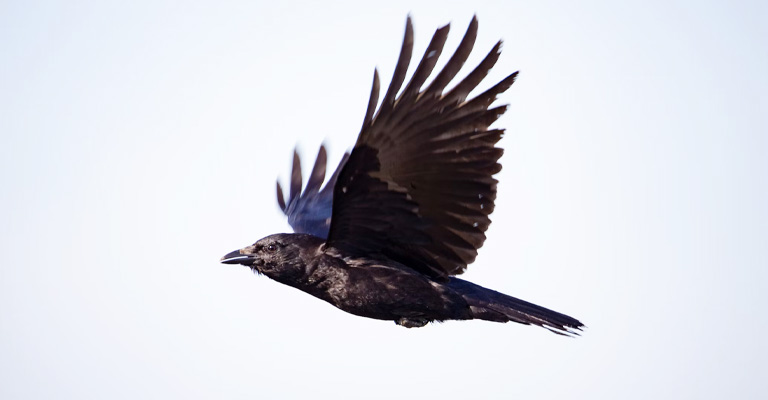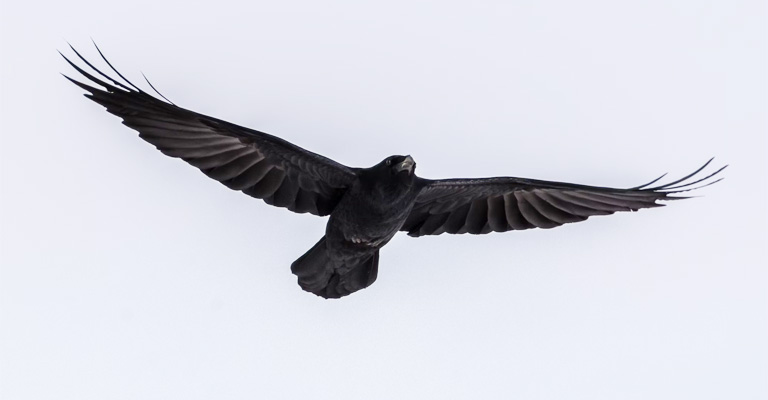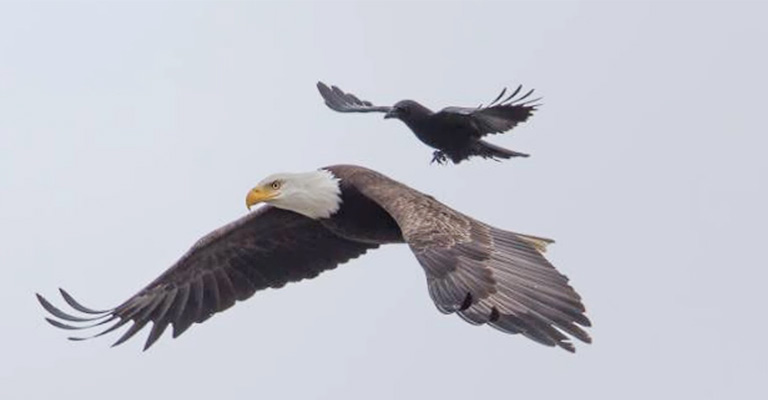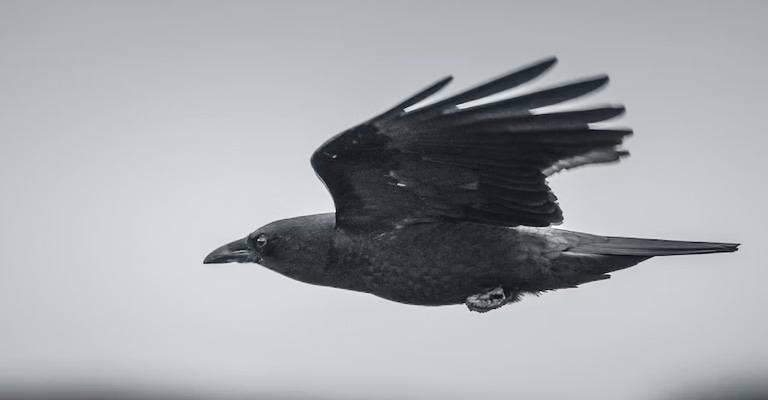Crows, often overlooked in the avian world, possess remarkable attributes that make them intriguing subjects of study.
One of the most captivating aspects of these black-feathered creatures is their flight speed. Have you ever wondered just how fast can a crow fly?
In this exploration, we embark on a journey through the skies to uncover the secrets of crow flight.
Crows are ubiquitous in urban and rural landscapes, showcasing their intelligence and adaptability. But what about their speed when they take to the air?
Understanding their velocity not only sheds light on their survival strategies but also unveils the mysteries of their graceful aerial displays.
As we delve into this avian enigma, we’ll discover the factors that influence crow flight speed, ranging from anatomy to environmental conditions. Join us in this thrilling pursuit of knowledge as we unravel the true potential of these feathered marvels.

How Fast Can a Crow Fly?
Before we delve into the specifics of a crow’s speed, let’s start with the basics of their flight. Crows belong to the family Corvidae, which includes ravens, magpies, and jays. These birds are known for their strong wings, agile flight, and remarkable adaptability.
The crow’s wings are designed for powered flight, meaning they can flap their wings to generate lift and thrust. Unlike soaring birds like eagles or vultures, crows rely on active flapping to stay aloft.
Crows are medium-sized birds with a wingspan that typically ranges from 32 to 40 inches (81 to 102 cm).
They have relatively short and rounded wings, which provide them with maneuverability and the ability to navigate through cluttered environments, such as forests and urban areas.
The Average Speed of a Crow
The average flying speed of a crow typically falls in the range of 20 to 30 miles per hour (32 to 48 kilometers per hour). This speed range is well-suited to their foraging habits and daily activities.
Crows are known to cruise at moderate speeds while patrolling their territories, searching for food, and engaging in social interactions.
However, it’s essential to note that crows can achieve higher speeds when necessary. When they are flying with a strong tailwind or during migratory flights, they can reach speeds on the higher end of this range.
In contrast, when they are engaged in more precise tasks like hunting for insects or navigating densely vegetated areas, their flight tends to be slower and more controlled.
Variation Among Crow Species
It’s important to note that crow species may exhibit some variation in flight characteristics. For example, the American Crow (Corvus brachyrhynchos) and the Carrion Crow (Corvus corone) are known for their relatively strong, direct flight.
In contrast, the House Crow (Corvus splendens) is a more agile and acrobatic flier. The Hooded Crow (Corvus cornix) displays versatility, as it can fly both at high altitudes and low over water or the ground.
Factors Influencing Crow Flight Speed

Several factors influence the speed at which a crow can fly. These factors can be broadly categorized into intrinsic and extrinsic factors.
Intrinsic Factors
Younger, healthier crows tend to be more agile and faster flyers than older individuals. In many bird species, males tend to be slightly faster flyers due to differences in muscle mass and size.
Genetic factors play a role in determining a crow’s overall fitness and flight capabilities.
Extrinsic Factors
Wind speed and direction can significantly impact a crow’s flight speed. Tailwinds can assist crows in achieving higher speeds, while headwinds can slow them down. The terrain and environment in which a crow is flying can affect its speed.
Open areas allow for faster flight, while densely wooded or urban areas may require slower, more agile flight. The reason for the flight also matters. Crows may fly at different speeds when foraging, migrating, or engaging in territorial disputes.
Can a Crow Fly Higher Than an Eagle?

To understand the potential altitudes of crows and eagles, we must first consider their physical characteristics. Crows, which belong to the corvid family, are medium-sized birds with relatively short wings and a wingspan ranging from 32 to 40 inches (81 to 102 cm).
These wings are designed for powered flight, allowing them to generate lift and thrust through active flapping. Crows primarily rely on their wing muscles for sustained flight.
On the other hand, eagles, a group that includes species like the bald eagle and the golden eagle, are large raptors with wingspans that can exceed 7 feet (2.1 meters).
Their long wings are adapted for soaring flight, which means they can glide on rising air currents and maintain altitude with minimal effort. Soaring birds, like eagles, have evolved for efficiency and can reach higher altitudes more easily than flapping birds.
The Factors Influencing Altitude h3
Several factors influence the maximum altitude a bird can attain, and these factors often favor soaring birds like eagles:
Wing Shape
The wing shape of an eagle is designed for soaring, with broad, elongated wings and plenty of surface area. This allows them to efficiently catch rising air currents, such as thermals, and gain altitude effortlessly.
Crows, with their shorter, rounded wings, are less suited for soaring and are better adapted for maneuverability and flapping flight.
Muscle Types
Birds that rely on powered flight, like crows, have strong, fast-twitch muscles suitable for quick and powerful wing beats. These muscles are excellent for short bursts of speed but can lead to rapid fatigue.
In contrast, soaring birds, such as eagles, possess more slow-twitch muscles, which are less fatiguing and enable them to maintain altitude for extended periods.
Behavioral Differences
Eagles often spend long hours gliding and soaring while searching for prey, which naturally takes them to higher altitudes.
Crows, while capable of reaching some heights, typically do not engage in sustained soaring behavior due to their foraging and scavenging habits, which often keep them at lower altitudes.
Typical Altitudes for Crows and Eagles
Eagles, especially species like the golden eagle, are renowned for their soaring abilities and can attain impressive altitudes. They have been documented flying at altitudes exceeding 20,000 feet (6,100 meters) during migratory flights.
Golden eagles, in particular, are known for their incredible aerial feats and high-altitude flight.
In contrast, crows are more commonly seen at lower altitudes. They typically fly at heights that range from treetop level to a few hundred feet above the ground.
Crows rely on powered flight and use their agility and maneuverability to navigate through their surroundings efficiently.
These lower altitudes are where they engage in activities like foraging, territorial displays, and interaction with other crows.
Variability Among Species and Individuals
It’s essential to note that there can be some variability among species and even individual birds within a species.
For example, the thick-billed raven, a large corvid species, has been known to soar at higher altitudes in the Himalayas, where it can reach elevations of up to 29,000 feet (8,800 meters).
However, this behavior is an exception among corvids and not representative of all crow species.
Moreover, individual eagles may exhibit differences in their soaring abilities and altitudes reached. Factors such as age, experience, and even environmental conditions can influence the altitude an eagle achieves during flight.
Why Do Crows Fly High?

Crows are often seen flying at varying altitudes, including high in the sky, for several reasons. These birds are highly recommended adaptable and exhibit complex behaviors, which contribute to their choice of flight altitudes.
Scouting for Food
Crows are opportunistic feeders and often fly high to scan larger areas for potential food sources. From an elevated vantage point, they can spot potential prey or scavenging opportunities like roadkill or garbage.
Predator Avoidance
Flying at higher altitudes provides crows with a strategic advantage against their natural predators, such as hawks and eagles. When high in the sky, crows can detect approaching threats from a greater distance and take evasive action.
Migration
Some crow species engage in seasonal migrations, during which they fly at different altitudes. High-altitude flights can help them cover long distances efficiently while avoiding obstacles on the ground.
Territory Surveillance
Crows are highly territorial and often engage in aerial displays and vocalizations to defend their territory. Flying high allows them to monitor their territory’s boundaries effectively and deter intruders.
Communication
Crows are social birds that use various vocalizations and body language to communicate with each other. High-altitude flights may be a part of their communication system, enabling them to convey information over larger distances.
Thermals and Wind
Crows take advantage of rising thermals and wind currents to conserve energy. Flying at higher altitudes allows them to glide more easily on air currents, reducing the effort required for sustained flight.
Flying at different altitudes might also aid in navigation. High-altitude flights could help crows gain a broader perspective of their surroundings, helping them locate landmarks and navigate effectively.
FAQs
What do crows eat?
Crows are highly adaptable omnivores with a diverse diet. They consume a wide range of foods, including fruits, seeds, insects, small vertebrates, carrion (dead animals), and even human food scraps.
Are crows and ravens the same bird?
Crows and ravens are closely related but are distinct species. They belong to the same family (Corvidae) and share many characteristics, including high intelligence and problem-solving abilities. However, they have differences in size, appearance, vocalizations, and behavior.
Do crows migrate?
Crows are known to exhibit seasonal movements, but they are not typically long-distance migrants like some bird species. In many regions, they may undergo seasonal movements related to changes in food availability and weather.
Why do crows gather in large groups?
Crows often gather in large groups, especially during the non-breeding season, for various reasons. These communal roosts provide safety in numbers, as they can help deter predators and provide warmth during the night.
Do crows have a positive or negative impact on ecosystems?
Crows play complex roles in ecosystems, and their impact can vary. While they are scavengers that help clean up carrion, they can also predate on the eggs and nestlings of other bird species, potentially affecting local bird populations.
Conclusion
The world of crows, these enigmatic creatures, holds fascinating secrets in their flight speed. Our journey through the skies has revealed that crows can reach speeds of up to 40 miles per hour, displaying an impressive combination of power and agility.
However, their actual speed can vary due to factors such as wind conditions and individual fitness.
Understanding the speed of a crow’s flight is not just a matter of curiosity; it provides valuable insights into their survival tactics, foraging habits, and ability to thrive in diverse environments.
From cityscapes to rural landscapes, these birds continue to captivate us with their adaptability and intelligence.
As we reflect on the mysteries of crow flight, we can appreciate these birds even more for their incredible capabilities.
Crows, with their quicksilver movements and aerial prowess, are a testament to the beauty and complexity of the natural world. Our quest to uncover the secrets of crow flight reminds us of the wonders that exist right above us in the open skies.